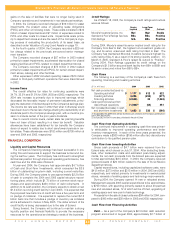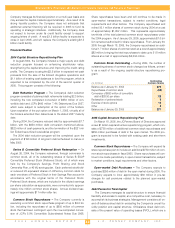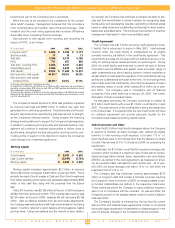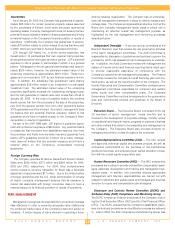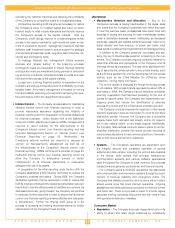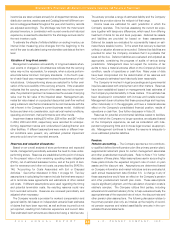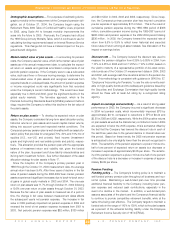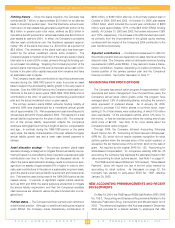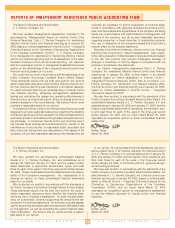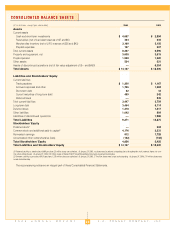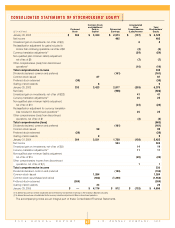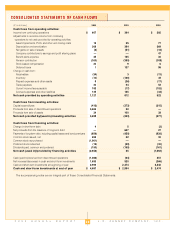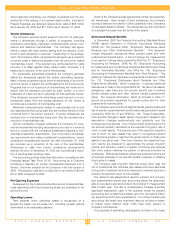JCPenney 2004 Annual Report Download - page 22
Download and view the complete annual report
Please find page 22 of the 2004 JCPenney annual report below. You can navigate through the pages in the report by either clicking on the pages listed below, or by using the keyword search tool below to find specific information within the annual report.
J.C. PENNEY COMPANY, INC.2 004 ANNUAL REPORT
Management’s Discussion and Analysis of Financial Condition and Results of Operations
20
Demographic assumptions
— For purposes of estimating demo-
graphic mortality in the measurement of the Company’s pension obli-
gation, as of October 31, 2004, the Company began using the
Retirement Plans 2000 Table of Combined Healthy Lives, projected
to 2005, using Scale AA to forecast mortality improvements five
years into the future to 2005. Previously, the Company had utilized
the 1983 Group Annuity Mortality Table, which it continues to use for
calculating funding requirements based on Internal Revenue Service
regulations. This change did not have a material impact on the pro-
jected benefit obligation.
Market-related value of plan assets
— In accounting for pension
costs, the Company uses fair value, which is the market value of plan
assets as of the annual measurement date, to calculate the expect-
ed return on assets and gain/loss amortization components of net
periodic pension expense. If the Company were to use a calculated
value, such as a three- or five-year moving average, to determine the
market-related value of plan assets and recognize variances from
expected results on a delayed basis, the amount of pension expense
or income recognized could vary significantly from that recorded
under the Company’s current methodology. This would have been
especially true in 2003 and 2002, given the significant decline in the
global equity markets. The fair-value approach, which is the
Financial Accounting Standards Board’s (FASB’s) preferred method-
ology, required the Company to reflect this decline in the fair value of
the plan’s assets.
Return on plan assets
— To develop its expected return on plan
assets, the Company considers its long-term asset allocation policy,
historical returns on plan assets and overall capital market returns,
taking into account current and expected market conditions. The
Company’s primary pension plan is well diversified with an asset allo-
cation policy that provides for a targeted 70%, 20% and 10% mix of
equities (U.S., non-U.S. and private), fixed income (investment-
grade and high-yield) and real estate (private and public), respec-
tively. This allocation provides the pension plan with the appropriate
balance of investment return and volatility risk, given the funded
nature of the plan, its present and future liability characteristics and
its long-term investment horizon. See further discussion of the asset
allocation strategy for plan assets in Note 17.
Since the inception of the Company’s primary pension plan in
1966 through the October 31, 2004 measurement date, the average
annual return has been 9.4%. After three years of decline in the fair
value of pension assets during the 2000-2002 bear market, pension
assets experienced significant increases due to back-to-back annu-
al gains in global equity markets in 2003 and 2004. The one-year
return on plan assets was 11.7% through October 31, 2004 following
a19.5% one-year return on plan assets through October 31, 2003.
Because the fair value of plan assets is measured as of a point in
time, the change in fair value between measurement dates affects
the subsequent year’s net pension expense. The increase in fair
value in 2003 positively impacted net pension expense in 2004 and
reversed the trend of net pension expense increases from 2001 to
2003. Net periodic pension expense was $82 million, $130 million
and $24 million in 2004, 2003 and 2002, respectively. Since incep-
tion, the Company’s primary pension plan has incurred cumulative
pre-tax expense of approximately $114 million. This is the result of
cumulative pension expense during the 1966-1984 period of $366
million, cumulative pension income during the 1985-2001 period of
$488 million and pension expense in the 2002-2004 period totaling
$236 million. In 2002, the Company lowered the expected rate of
return from 9.5% to 8.9% to reflect lower historical and expected
future rates of return among all asset classes. See discussion of the
impact on earnings below.
Discount rate
— The Company lowered the discount rate used to
measure the pension obligation from 6.35% to 5.85% in 2004, from
7.10% to 6.35% in 2003 and from 7.25% to 7.10% in 2002, based on
the yield to maturity of a representative portfolio of AA-rated corpo-
rate bonds as of the October 31 measurement dates in 2004, 2003
and 2002, with average cash flow durations similar to the pension lia-
bility. This methodology is consistent with guidance in SFAS No. 87,
“Employers’ Accounting for Pensions,” to use the rate currently avail-
able on high-quality bonds and the subsequent guidance issued by
the Securities and Exchange Commission that high-quality bonds
should be those with at least AA rating by a recognized rating
agency.
Impact on earnings and sensitivity
— As a result of strong asset
performance in 2003, the Company incurred a significant decrease
in 2004 net pension costs, which incrementally improved EPS by
approximately $0.10, compared to reductions in EPS of $0.24 and
$0.20 in 2003 and 2002, respectively. While the 2004 positive returns
on plan assets as well as the discretionary contribution made in 2004
are expected to lower the 2005 expense, this is somewhat offset by
the fact that the Company has lowered the discount rate in each of
the last three years due to the general decline in interest rates over
this period. Based on these trends, the 2005 net pension expense
is anticipated to be only slightly lower than the amount recognized in
2004. The sensitivity of the pension expense to a plus or minus one-
half of one percent of expected return on assets is a decrease or
increase in expense of approximately $0.05 per share. The sensitiv-
ity of the pension expense to a plus or minus one-half of one percent
of the discount rate is a decrease or increase in expense of approx-
imately $0.09 per share.
Pension Funding:
Funding policy
— The Company’s funding policy is to maintain a
well-funded primary pension plan throughout all business and eco-
nomic cycles. Maintaining a well-funded plan over time provides
additional financial flexibility to the Company, including lower pen-
sion expense and reduced cash contributions, especially in the
event of a decline in the market. In addition, a well-funded plan
assures associates of the plan’s and the Company’s financial ability
to continue to provide competitive retirement benefits, while at the
same time being cost effective. The Company targets to maintain a
funded ratio in the range of 110% to 130%, which is the plan’s assets
as a percent of the actuarial funding liability under the Employee
Retirement Income Security Act of 1974 (ERISA).


